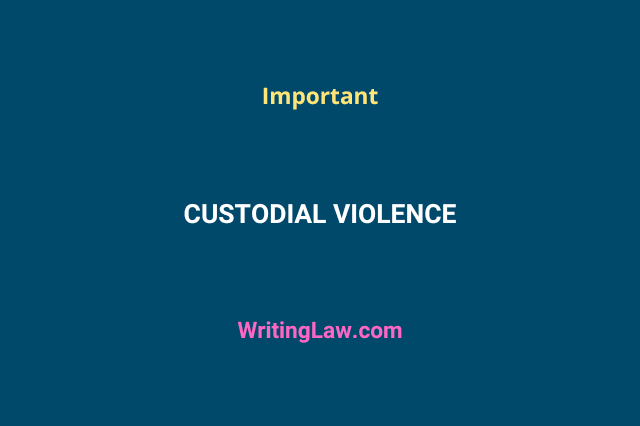
The Chambers Dictionary defines custody as the state of being detained by the police, arrested, or imprisoned. Violence is the use of force against another person with the intention of harming them. The harm could be either psychological, physical or in any other way.
Building on the above definitions, custodial violence means torture or other forms of violence committed against any person or group of people while they are in the custody of the police or a court. It is a punishable offence.
In this article, you will read about the meaning, types, causes and protection available against custodial violence in India.
Meaning of Custodial Violence
All forms of physical and psychological abuse inflicted on a person in police custody are referred to as custodial violence. The term custodial violence has not been defined under any law. However, as per the Law Commission of India, any criminal conduct by a public employee against an individual who has been arrested or detained and is in custody can be termed as custodial violence.
Custodial violence can take the form of illegal detention, wrongful arrest, victimisation of suspects, coerced information gathering, and any physical, psychological, and sexual abuse.
Types of Custodial Violence
There are three types of custodial violence:
1. Physical Violence
It refers to the use of physical force to cause injury or harm to the person in custody. This is the most common violence used by public officials.
2. Psychological Violence
It deals with the mental aspect of the person in custody. It may involve denying the victim necessities like food, water, sleep, or bathroom.
3. Sexual Violence
Any sexual act or attempt of sexual act using violence is known as sexual violence. This includes rape, sodomy, etc.
Causes of Increasing Custodial Violence
There are several reasons behind the increasing trend in custodial violence by public servants. Five of the prominent ones are:
1. Absence of Anti-Torture Law
The biggest cause of prevailing custodial violence in India is the absence of an anti-torture law.
2. No Fear in Police Officials
There is no fear in police officials of getting caught for violence because of the loopholes in the governmental system. As a result, it motivates them to use aggressive ways to gather information from the person in custody or punish their enemies.
3. Lack of Awareness Among the General Public
As most of the public is unaware of their rights, police officers feel empowered to continue using harsh methods to deal with them.
4. Lack of Proper Training
Another possible cause of custodial violence is inadequate training. The police officers lack the necessary training to handle suspects. Their emotional intelligence is not given enough consideration, and because it is unmonitored, they are more likely to act violently.
5. Huge Responsibility on the Police Officials
Lastly, they are under pressure to adopt quicker means to solve a case because of the huge workload on their shoulders. Under this pressure, some police officers resort to aggressive tactics to obtain information.
Protection Against Custodial Violence
The protection against custodial violence is provided under various existing laws of the country. Here are some of them.
The Constitution of India
Prisoners are guaranteed the same rights and dignity as other Indian citizens under the Constitution of India. Article 14 of the Indian Constitution guarantees equal treatment to the persons in custody.
Article 21 of the Constitution of India deals with the right to life and personal liberty, which is also available to prisoners or persons in custody.
Further, Article 20 of the Indian Constitution provides that a person should not be convicted for the same offence twice and that the person cannot be forced to be a witness against himself.
The National Human Rights Commission
The National Human Rights Commission gives comprehensive directions on pre-arrest, during-arrest, and post-arrest procedures in addition to the idea of enforcing these guidelines and directions.
The Code of Criminal Procedure
The 2009 amendment to section 41 of the Criminal Procedure Code added protections for people in custody in sections 41A, 41B, 41C, and 41D. The amendment ensures that interrogation-related arrests and detentions must have legal justifications and follow established procedures.
The Indian Evidence Act
A confession made by an accused to a police officer or while he is in jail cannot be used against them, according to section 25 and section 26 of the Indian Evidence Act. A magistrate must be present when a confession is made to the police officer to make it admissible.
The Indian Police Act
As per sections 9 and 27 of the Indian Police Act, 1949, a police officer who violates the law will be subject to punishment, suspension, and dismissal.
Conclusion
Torture and other types of violence done against an individual or group of individuals while they are in the custody of the police or a court are referred to as custodial violence. Custodial violence can be classified into three categories as physical, psychological and sexual violence. There are several reasons behind the increasing trend in custodial violence by police officers or officials that we mentioned above.
Read Next:
1. Custodial Deaths: A Matter That Requires Immediate Attention
2. What Are the Legal Protections Available to an Accused
3. What Is Judicial Custody and Police Custody Under CrPC?
- Understanding the Legislative Branch of the Indian Government - 6th May 2024
- Appointment, Oath, and Removal of Constitutional Posts in India - 28th April 2024
- Powers of Income Tax Authorities in India - 26th April 2024







